Brief
Call it the arugula effect. A major US commercial insurance carrier was dissatisfied with its approach to supermarket general liability risk. The conventional lens on customer segments was too crude and masked the presence of good risks within broad segments such as inner-city supermarkets. So the carrier mined geographic data block by block and discovered a subsegment of grocery stores that had a more attractive risk profile. This group of stores made more than one-third of its sales from fresh produce such as arugula, did not use drop-down security gates, and each store was located within two blocks of a health club and 24-hour parking garage. By targeting such stores with more favorable pricing and eliminating cross-subsidies, the carrier realized a four percentage point improvement in its combined ratio.
Using advanced customer analytics can lift performance and create competitive advantage in an industry where most US carriers have not consistently earned a return on equity that covers their cost of capital. Despite a mediocre showing for the industry overall, performance varies widely among individual insurers, with top-decile firms substantially outperforming competitors, and indeed matching elite performers in other industries. In the personal auto market, for instance, the compound annual growth rate (CAGR) for direct premiums written from 2002 through 2011 ranged from -6.4% to 28% among various companies that Bain analyzed, and the average simple combined ratio ranged from 63% to 98%. We found a similar variance in commercial lines (see Figure 1).
Many of the high-performing carriers have some common characteristics, most notably their reliance on advanced customer analytics. Almost all property and casualty (P&C) insurers today have at least rudimentary analytical capabilities, but they tend to be confined to an actuarial group using traditional loss and underwriting data, and to focus narrowly on how loss prediction can improve pricing. High-performing firms, in contrast, take a more expansive and ambitious approach.
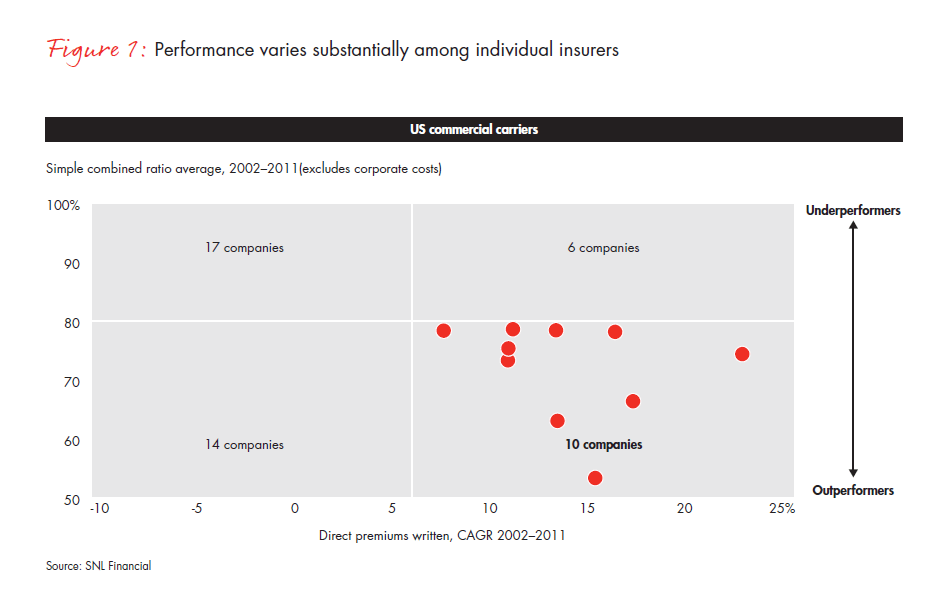
First, they find meaningful linkages between claims and measures of personal responsibility, looking beyond actuarial data to uncover new data sources outside insurance, from divorce filings to records of smoking behavior and magazine subscriptions. The personal data serves as a surrogate for indicators of risk, augmenting the traditional indicators such as a house’s distance from a fire hydrant. Analytics leaders are teasing out patterns with strong predictive power and putting those patterns to good use in decisions about which customers to target with which offerings and around how to optimize operations.
In addition, many of the analytics leaders take a practical approach. While they’re comfortable with “big data,” they’re not obsessed with developing a proprietary “black box” that mines the data to spit out an answer. Rather, they draw up a reasonable hypothesis, test it using the best data that’s quickly available and put the analytical insights into practical operation. Through a closed-feedback loop, they regularly gather customer comments that prompt frontline employees and managers quickly to make adjustments in underwriting, pricing, claims and other areas.
Most of the analytical advances to date have come in personal auto and small commercial lines, where losses are frequent and relatively low, on average. The performance leaders over the next few years will extend these techniques to areas such as workers’ compensation and homeowners insurance, where losses generally are less frequent but more severe. Sophisticated analytics are still nascent in areas where losses are extremely infrequent and highly severe, such as professional liability and excess casualty, but these lines hold great promise as well.
Five sources of competitive advantage through analytics
The leading companies typically apply analytics to yield fresh insights and inform better business decisions in five areas: risk selection and pricing, customer loyalty and advocacy, claims management, business cycle management and capital efficiency. Let’s look at each in turn.
1. Risk selection and pricing
Despite the fact that most insurers have concentrated their analytical firepower on this area, there remain plenty of opportunities to generate new insights. Specifically, companies are finding new correlations every day between target customer segments and risk at a much more granular level. For the coverage of inner-city supermarkets, the stocking of arugula and the lack of drop-down gates turned out to be key variables. In professional liability coverage for lawyers, another carrier discovered that an attractive, low-risk subsegment consisted of solo lawyers with at least 20 years of experience, a sharply defined focus area, and a practice in a town with a population between 10,000 and 25,000.
Some companies are combining individual customer data with behavioral science techniques to nudge people to do the right thing and thereby lower the overall level of risk in the portfolio. Progressive Insurance, for example, has rolled out a voluntary program called Snapshot that deploys telematics to gather information about how and how much an individual drives in order to target discounts accurately at careful drivers and charge more spirited drivers an appropriate higher premium (see Figure 2). The Snapshot rating system uses a small digital device that plugs into a car’s diagnostic port and communicates actions such as sharp cornering and harsh acceleration via satellite to Progressive. Products customized around driving patterns and auto usage, which depend on analysis of big data produced by the devices, have finally become technically and economically feasible. This type of “user-based” insurance could account for about one-fifth of the personal auto market within five years.1
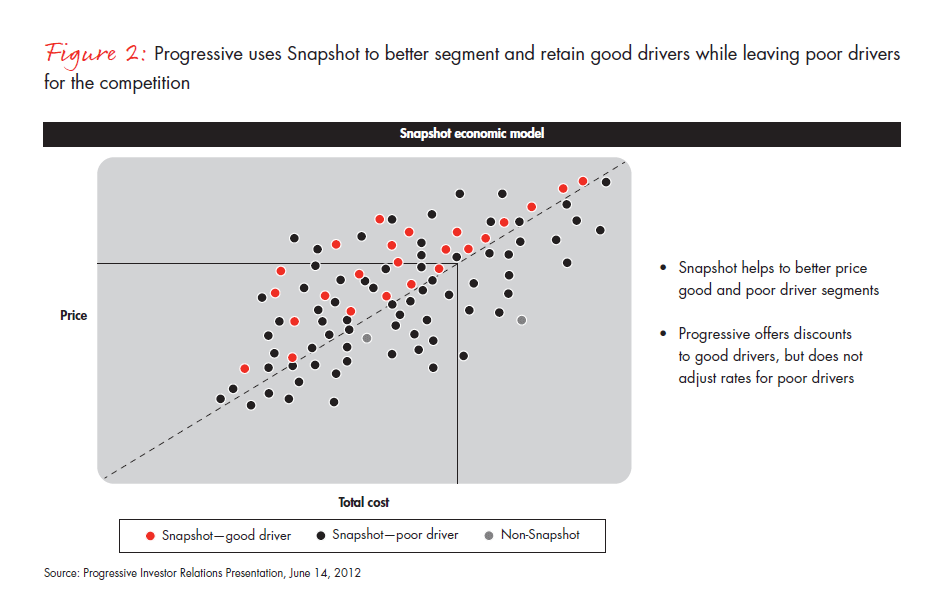
Analytics can improve the profitability of a carrier’s customer mix through a robust adverse selection strategy: actively targeting high-profit potential customers with attractive pricing and by repricing the existing book, driving the worst risks to competitors. We estimate that P&C carriers can improve their combined ratio by three to five percentage points and their premium growth by 5% to 15% above baseline expectations.
2. Customer loyalty and advocacy
A different type of data is being used by insurance companies to catalyze operations around the goal of raising the level of advocacy among customers. The Net Promoter ® system (NPS®) tracks how customers perceive the carrier and its products and services, sorting customers as promoters or detractors to produce a net score that monitors the quality of customer relationships.
Net Promoter companies communicate this feedback throughout their organization. They create learning and improvement processes to increase promoters and reduce detractors. But closed-loop processes can fade away without strong leadership and cultural reinforcement. Allianz’s Australian P&C unit dealt with this challenge by having the top executives personally call customers each month and by using employee rewards and recognition. Managers in each sales office, claims facility and call center maintain a “compliment database,” where they register feedback that praises frontline employees by name. Individual employees’ successes are celebrated at regular “town hall” meetings hosted by a senior Allianz executive.
The business payoffs from customer advocacy are substantial: Bain estimates that the lifetime profit from a new policyholder in auto insurance averages $537 for a promoter, more than five times the $100 profit for an average detractor and more than twice the value of a passive customer. The incremental value stems mostly from greater retention plus word-of-mouth recommendations and a minor boost from cross-selling opportunities (see Figure 3).
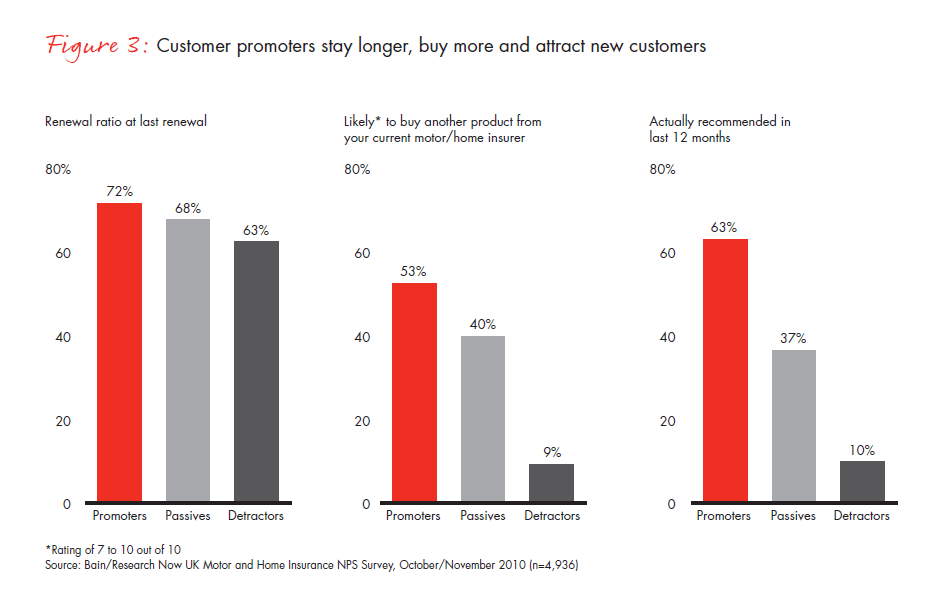
Brazil-based Porto Seguro has consistently ranked first in customer loyalty among auto insurers in that market. The company has used analysis of customer feedback to improve frontline customer service and to create innovative offerings that both delight customers and improve the company’s economics. For instance, Porto Seguro offers policy holders free mechanical checkups, which improve safety. Before third brake lights were the industry standard, the company offered them free to customers as a way to reduce loss ratios. It determined that customer discounts for parking garages, to discourage parking on the street, positively affected both loyalty and loss ratios. The company also offers free locksmith, plumbing and electrician services on top of auto insurance, to help propel sales, margins and loyalty. Strong customer loyalty, and the astute use of customer feedback to craft new offerings, has contributed to Porto Seguro’s strong performance relative to competitors in revenue growth, loss ratios and return on capital over the past five years.
One of the highest-performing multiline US carriers in recent years, as measured by combined ratio and growth in direct premiums written, also has consistently earned the highest NPS score among auto insurers. This company, which we will call MultiSurance, targets well-defined customer segments and tailors its service to meet the distinct needs of these customers. MultiSurance’s NPS survey responses from customers go through a fast feedback loop to employees so that problems can be flagged and fixed, or to highlight what employees are doing right and reinforce those behaviors—all with the goal of improving the customer’s experience. Multi-Surance also links management evaluations to customer retention, which helps keep all levels of the organization focused on the same goals.
Besides cementing loyalty, analytics can be used to generate sales leads and raise customer acquisition yields and cross-selling levels. MultiSurance’s extensive loyalty program has lowered price sensitivity among customers and greatly improved the company’s ability to cross-sell products. Using customer databases to identify opportune moments when customers are receptive to a sales overture, such as when they are buying a home or expecting a baby, MultiSurance now averages more than three products per customer.
3. Claims management
How a carrier interacts with customers to handle claims stands as a key moment of truth. Indeed, among certain P&C lines, Bain has found that claims management is the area with the greatest potential to anger or delight customers (see Figure 4).
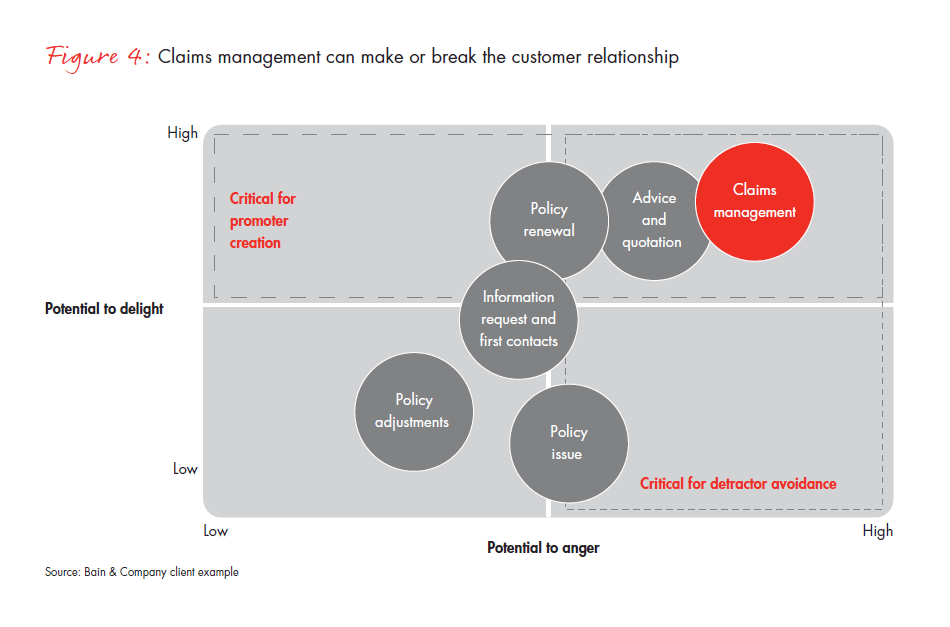
Customer loyalty initiatives thus should include a focus on achieving a great customer experience during the claims process while also reducing loss adjustment costs and optimizing loss expenses. Although most carriers understand the need to balance this triangle of imperatives, few have perfected the balance. Many tend to emphasize the loss adjustment side of the triangle, trying to lower costs through outsourcing, automation or other means. The danger is that lower costs come at the expense of a degraded customer service experience that foments frustration and anger—a penny-wise, pound-foolish approach.
Analytics can help strengthen claims management by devising smarter segmentation of customers and their predicted behavior (through latent class regression modeling) and more accurate prediction of the likelihood and timing of relevant events (through hazard modeling). These scientific methods raise one’s confidence about the projected frequency and amount of claims, and they’re increasingly relevant as one moves to more complex types of claims. Leading carriers are starting to use algorithms to segment claims at the outset by their complexity and tailor the adjudication process by the type of claim.
Equally as important, however, is how well customers are managed through the claims process. Some leading companies are giving customers a greater role in the process by, for example, encouraging drivers to shoot photographs of their auto accident on their smartphone and email those pictures from the scene. Smartphones and other mobile devices in particular will foster new types of customer interactions and create new types of customer data.
Zenith Insurance, which specializes in worker’s compensation, has excelled in claims management for the California agriculture industry by combining analytics with medical management that actively motivates the injured employee to return to work. Zenith does deeper regional and agricultural sector segmentation than most of its competitors do. And its return-to-work programs and medical networks are customized for each segment. Partly as a result of these measures, Zenith has enjoyed a combined ratio that has been, on average, 21 percentage points lower than competitors over the past decade.
4. Management of business cycles
P&C carriers understand that the business is cyclical in nature, with prices softening or hardening depending on the stage of the cycle. When carriers see the start of a downward trend, they put on the brakes by writing less new coverage, renewing fewer policies and waiting for the cycle to turn.
But some carriers capitalize early on cycle-driven opportunities. They use analytics to identify niche markets that buck the general trend, or they anticipate and act on turns in the cycle sooner than competitors do. In personal home insurance lines, one region might continue to have a hard market while other regions are softening.
W. R. Berkley, one of the largest underwriters of commercial insurance, is also one of the most flexible because of how it manages insurance cycles. The company is willing to bend on revenues, but it stays profitable even in a tough market.
Berkley allows each of its dozens of subsidiaries in the US and abroad to make pricing decisions and respond quickly to local customer needs, within preset risk parameters. That decentralized approach makes Berkley more nimble than competitors that centralize pricing, helping it to expand across geographies and niche specialty segments such as life sciences. Over the past decade, Berkley has been among the most consistent outperformers in its combined ratio and growth in direct premiums written.
Superior cycle management also hinges on the ability to access and analyze data with a minimal time lag.
Bermuda-based RenaissanceRe, one of the best-performing reinsurers, updates its risk accumulation profile each time it underwrites a new risk. When RenRe underwriters and claims managers gather in a “war room” to review individual accounts, they have virtually real-time data that allows them to understand whether a particular line is deteriorating and they need to adjust prices or change their capital allocation. That gives RenRe an advantage of weeks over some competitors.
5. Capital efficiency
Besides allowing insurers to improve pricing, risk selection and claims management, analytics can also be a powerful tool in the CFO’s arsenal to better manage capital. Many P&C insurers are highly attuned to their cost of capital as they strive to grow profits over time. Customer analytics has a direct bearing on capital efficiency when it’s harnessed to the goals of improving risk selection, pricing and retention.
This dynamic plays out in a couple of ways. Analytics can strengthen customer loyalty, as discussed earlier, which reduces customer lapses (churn) and volatility; in turn, that lowers economic capital requirements and therefore raises the return on capital. Estimates by Bain and Towers Watson for one European insurer showed a 1% reduction in internally modeled solvency capital requirements with a 10% reduction in the volatility of lapses.
In addition, analytics help executives determine the likelihood of different risk scenarios for a line of business. Analysis of, say, a concentration of real estate coverage in a particular region will reveal whether that region’s claims are more or less volatile than others, whether it correlates with losses in other regions and so on. Products and segments with the same combined ratio can have different returns on risk-adjusted capital (RAROC), given the characteristics of the risks and the insurer’s portfolio.
The issue has become more urgent, as regulation in many countries is prompting increased investment in internal capital models and risk-adjusted decision making. The European Union, for example, is planning to phase in its Solvency II regulatory overhaul of the insurance industry beginning in January 2013. While the precise timing of the introduction and transition period is not settled, Solvency II will tighten requirements for how much capital insurance companies will need to hold, impose tough new rules governing how they identify and monitor risk and set strict disclosure guidelines to increase transparency. Analysis by Bain and Towers Watson shows that in some countries, such as Italy, a large share of P&C insurers currently lack sufficient capital to clear the higher Solvency II hurdle.2
However, the focus of advanced analytics should be to develop a competitive advantage in pricing and selecting risks, not to comply with regulation. Leading insurers are actively implementing sophisticated risk and capital-adjusted underwriting criteria and working to improve their RAROC. For example, Itaú Seguros, the leading P&C insurer in Brazil, uses RAROC as a competitive advantage because it gives the company a more precise measure of risk versus return and capital allocation.3 Other companies that choose to rely on simpler metrics, such as combined ratios, might end up on the wrong side of adverse selection.
Adapting the organization to the next level of analytics
By advancing in each of the five areas discussed here, carriers can realistically improve their combined ratio by three to five percentage points and their annual revenue growth by 5% to 15%. Moreover, advanced analytics will only grow more useful as the volume and types of data continue to proliferate in the future.
But carriers determined to exploit analytics more effectively may have to do more than hire analytics professionals and improve corporate capabilities. They will likely have to change underwriting practices, communicate new target customer segments to agents and adapt claims management processes based on analytical insights. Most European insurers, for instance, split analytics capabilities among marketing, claims, product development and even the IT function, making it difficult to coordinate an analytics project. Decision making and reporting structures within the organization thus may also need to change, so that staff in underwriting, distribution, claims, marketing, loss control and product and state management are all working in unison.
One sign of change came recently when Chartis Insurance, the P&C arm of AIG, elevated data analysis to a corporate-level capability, crossing all lines of business and functional areas, with the creation of a chief science officer position reporting directly to the CEO. The move could help Chartis to leapfrog competitors in realizing the benefits of analytics, as the company sees opportunities to apply analytics in the areas we’ve discussed here and also around climate change, harmful chemicals used in making plastics and other emerging risks.4
Carriers can start their own journey by assessing their current state of readiness and desired point of arrival (see Figure 5). To ensure that each function is aligned with the others, it’s worth considering alternative organizational approaches. One promising alternative is the product management approach, similar to what’s used by diversified food and beverage companies such as Kraft or Nestlé, which call it brand management because they give a brand manager broad decision-making authority over that brand. While the P&C industry differs from food in that it operates within a set of constraints defined by risk, the product management approach is taking hold at a few companies such as Progressive. The approach invests an executive with authority over most decisions for an entire product or segment, at the least for a large region and possibly nationwide. Designated underwriters, actuaries, claims specialists and marketers would all serve on the product team, with dotted-line reporting to the heads of their functions.
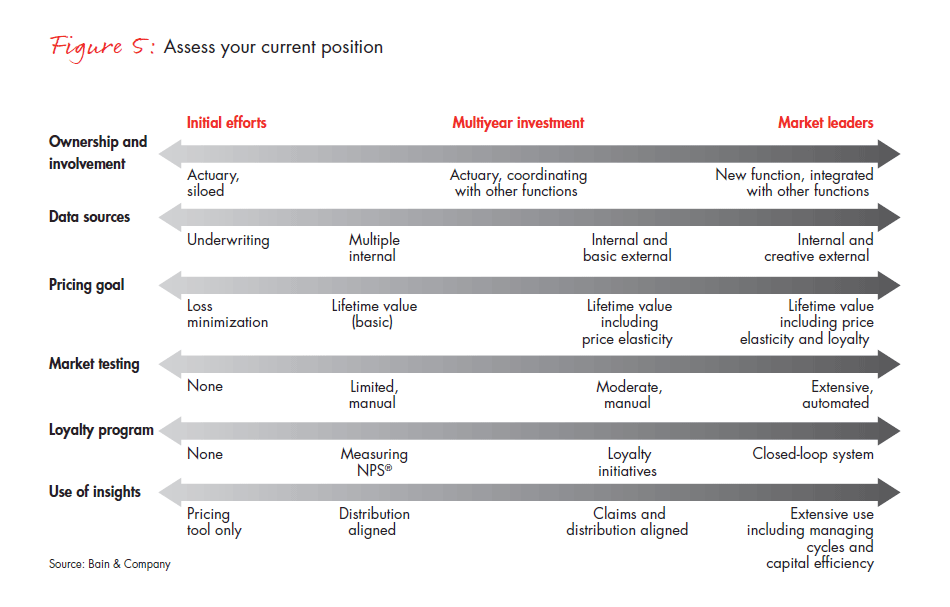
In the product management model, the analytics function could stand alone to serve each product group. Or analytics professionals could be distributed inside designated product groups. Taking the latter route raises the risk of isolating analytical staff, so a company should ensure that these employees have a strong mentor network and ample training and development opportunities.
Analytics can inform the key decisions in product management through a test-and-learn feedback loop. For example, when analytical tools uncover leading indicators for a spike in claims by a subgroup of customers—say, young drivers in California—that insight can lead to changes in pricing and customer selection. And in order to improve economics at an enterprise scale, insurers will want to develop a repeatable model—potentially on a global scale—where insights from the inland marine line are used to accelerate development of insights for directors and officers coverage.
As organizations become more fluent in analytics, they will be able to take more calculated risks by flagging a problem or a loss early on, allowing for midcourse adjustments. Note, however, that it’s critical to build a culture that celebrates measured risk-taking behavior, which can mark a departure from long-standing, risk-averse practices. Equipping employees to recognize a failure early on, shut it down quickly to contain the damage and share the lessons across the organization—that’s what it means to look risk in the eye confidently.
The authors are partners in Bain & Company’s Financial Services practice. Steven Kauderer is based in New York, Gunther Schwarz is based in Düsseldorf, Thomas Olsen is based in São Paulo and Seow-Chien Chew is based in Singapore. The authors thank Christy de Gooyer for her contributions to this brief.
Net Promoter® and NPS® are registered trademarks of Bain & Company, Inc., Fred Reichheld and Satmetrix Systems, Inc.
1“Auto Insurance Enters the ‘Pay-per-View’ Era,” the Wall Street Journal, June 13, 2012.
2“Solvency II rewrites the rules for insurers,” Bain & Company and Towers Watson, July 26, 2011.
3Itaú Seguros’s Form 20-F, US Securities and Exchange Commission, 2011.
4“Q&A With Chartis’ Buluswar: What Does a Chief Science Officer Do?” Insurance Technology, January 10, 2012.




